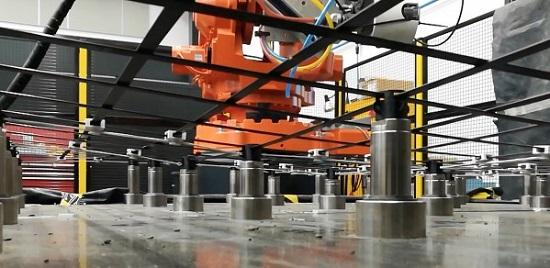An easy win is simply to use less concrete, by eliminating waste and overdesign. This is the focus of the UKRI-funded research project “Automating Concrete Construction (ACORN)”
ACORN is researching how digital design and automated production methods can be used to create concrete floor systems with drastically reduced CO2 emissions. This is achieved using a segmented thin-shell floor solution that can be produced off-site using robotics, and is designed to be transportable, demountable, and reusable at the end of its first life, enabling circularity in construction.
This interdisciplinary project includes researchers from the Universities of Bath, Cambridge, and Dundee. The research team in Cambridge, led by Dr John Orr, is working towards the realisation of a real-scale demonstrator of a 4.5 m x 4.5 m shell floor system. Their research is making use of new construction robotic facilities held within the National Research Facility for Infrastructure Sensing (NRFIS).
The fabrication of a segmented concrete shell required the team to design and fabricate an entirely new reusable and reconfigurable concrete mould (see video) that is compatible with our robotic spraying system. The realisation of this new mould demonstrates collaboration between the research team, and the Department of Engineering workshops.
The Department of Engineering’s in-house design team worked with ACORN researchers to develop a modular “pin-bed” solution that uses an array of computer-controlled pistons (actuators) that move vertically to support and deform a flexible formwork of composite strips and a fabric membrane to create a mould for concrete.
Thanks to this mould, the team can cast concrete shell segments, whether identical or different, with a single mould. This system allows mass-customisation and significantly reduces the waste and carbon content due to the necessary formwork of these efficient but more complex to build curved structures.
When challenged to realise the ACORN vision, the workshop team took inspiration from a project developed for the Whittle Laboratory, adapting this tried and tested solution to meet our specifications.
Senior Design Engineer Neil Houghton said “Using a proven design, adopted from an entirely unrelated research project, effectively de-risked this significant mechanical development and demonstrates the value of sharing technical know-how between entirely different research applications. This collaboration benefited the ACORN vision in terms of cost, timescales, effort, and technical risk.”
Cambridge lead investigator, Dr John Orr, said “The collaboration between our research team, the professional services team in the workshop, and our fabrication group, allowed us to realise a new concrete mould that will demonstrate the industrial feasibility of using a segmented thin shell concrete floor system. This has the potential to drastically reduce the amount of concrete used in our buildings and enables a circular economy as we have built in the potential for future reuse. The project has benefited enormously from the expertise within the Department, and from the input of our industrial steering group, who include 12 of the UK’s largest civil and structural design and construction companies.”
With this demonstrator and the release in 2022 of an open source version of the end-to-end design and fabrication tool, ACORN fuses the digital and physical realms, and hopes to drive the acceptance of a new culture in the construction industry: to use enough material – and no more.
Image: A modular “pin-bed” solution that uses an array of computer-controlled pistons (actuators) that move vertically to support and deform a flexible formwork of composite strips and a fabric membrane
Reproduced courtesy of University of Cambridge, Department of Engineering
